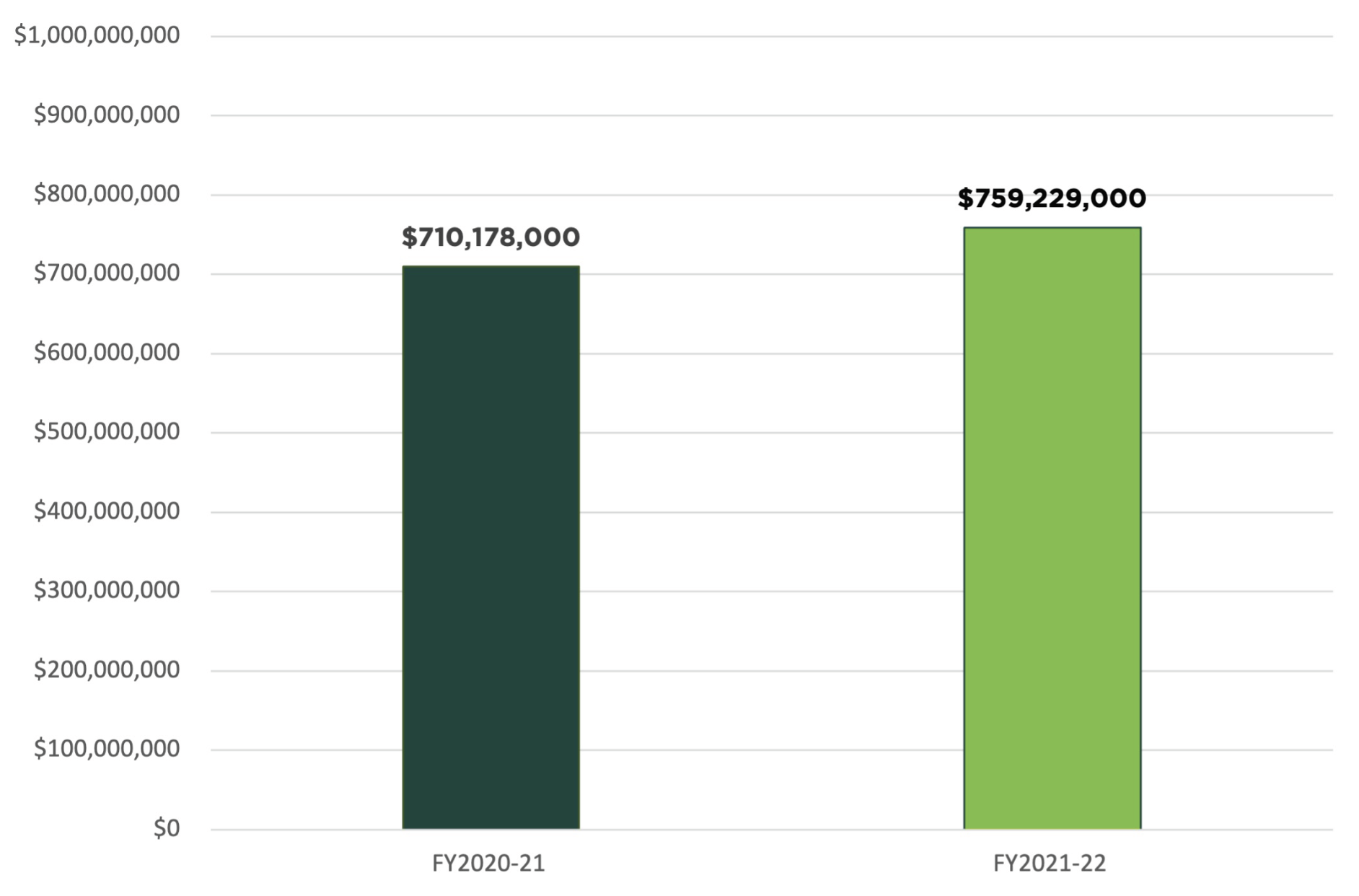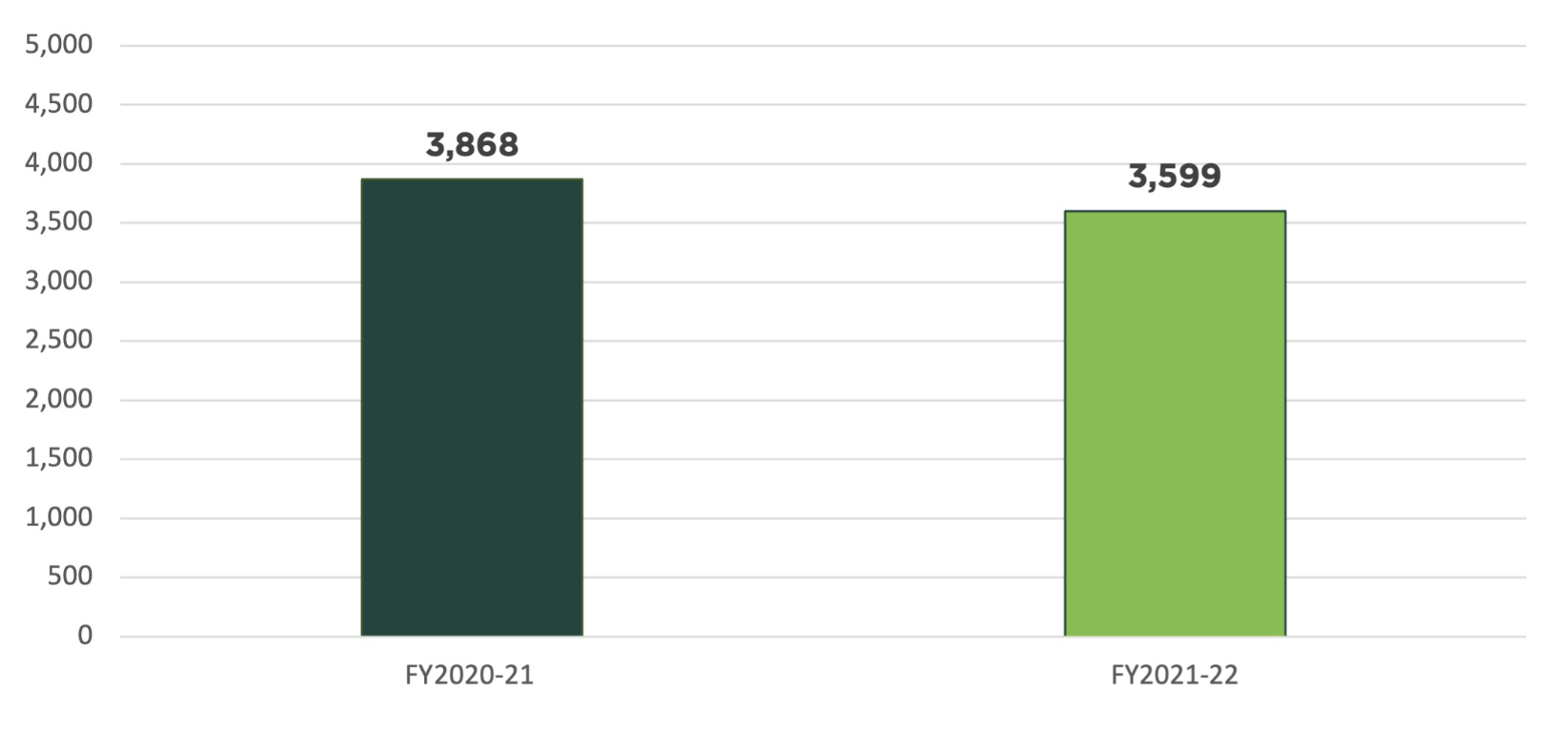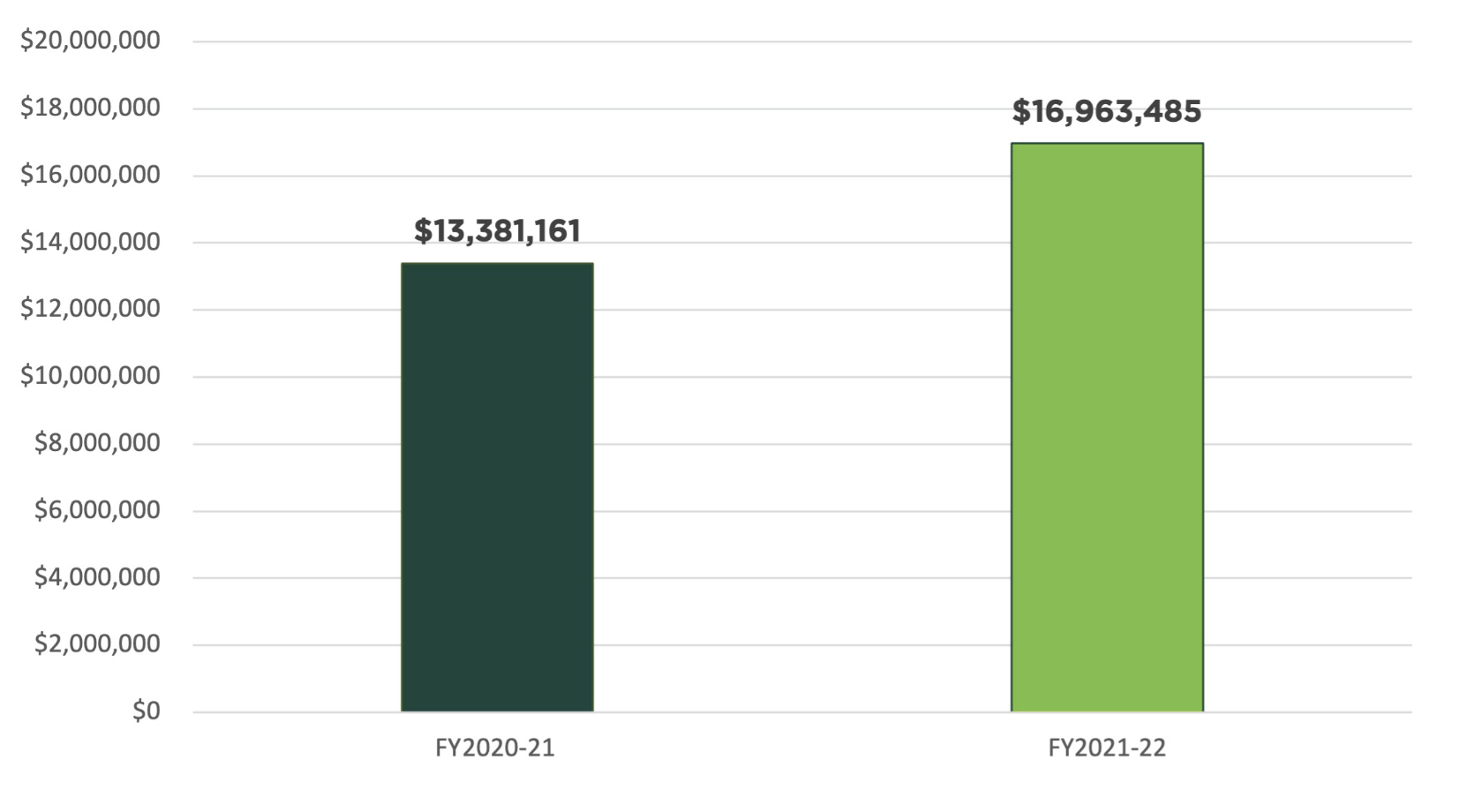Innovation for Global Impact 2023 Progress
Research and development expenditures, or funds spent to conduct research, are the most frequently cited and consistent data for comparing research levels among colleges and universities. This data is reported annually through the National Science Foundation Higher Education Research and Development, or HERD, survey.

The number of proposals submitted — as well as the size and scope of resulting awards — is a leading indicator of future research expenditures. While the number of submissions was down for FY2021-22, the proposals submitted were significantly larger in value.

MSU is forging new partnerships with business and industry that spur innovation and enhance economic development. The university will increase and diversify sources of research support.


MSU is investing in the Climate Change Research Support Program, new in 2022. This important funding mechanism supports promising new initiatives in key areas of research, scholarship and multidisciplinary collaboration in response to the global climate crisis. The program currently funds 12 research projects and five proposals for research team development, all in areas where MSU has unique capabilities and expertise to tackle multidimensional problems.
 MSU is growing health care research. The consolidation of Henry Ford Health with MSU Health Sciences research operations has resulted in more than 100 Henry Ford faculty receiving appointments in MSU departments, giving them access to university research resources and collaborative opportunities. The HFH + MSU Health Sciences joint research entity has been formed, and both MSU and Henry Ford faculty are now submitting new grant proposals, which are credited to MSU, growing our portfolio. More than 130 proposals have been submitted to date, focusing first on proposals to the National Institutes of Health, with submissions to other agencies to be phased in over the next year.
MSU is growing health care research. The consolidation of Henry Ford Health with MSU Health Sciences research operations has resulted in more than 100 Henry Ford faculty receiving appointments in MSU departments, giving them access to university research resources and collaborative opportunities. The HFH + MSU Health Sciences joint research entity has been formed, and both MSU and Henry Ford faculty are now submitting new grant proposals, which are credited to MSU, growing our portfolio. More than 130 proposals have been submitted to date, focusing first on proposals to the National Institutes of Health, with submissions to other agencies to be phased in over the next year.
 MSU is investing in the new Space Electronics Center. With support from Texas Instruments, the university will be at the forefront of the design and testing of devices and systems for space applications. The first testing sessions with TI involved replicating exposure to the ionizing radiation typically present in space. The new center will also provide industry and government representatives with opportunities for interaction and collaboration with MSU faculty, students and researchers. Activities will include research projects, workforce development, technical workshops and forums for small corporate delegations.
MSU is investing in the new Space Electronics Center. With support from Texas Instruments, the university will be at the forefront of the design and testing of devices and systems for space applications. The first testing sessions with TI involved replicating exposure to the ionizing radiation typically present in space. The new center will also provide industry and government representatives with opportunities for interaction and collaboration with MSU faculty, students and researchers. Activities will include research projects, workforce development, technical workshops and forums for small corporate delegations.
 MSU is partnering with the Michigan Economic Development Corporation to foster hiring in the electric vehicle and mobility industries within the state. The initiative helps blend the hands-on activities and theoretical knowledge that are hallmarks of an MSU education with the needs of 21st century employers. This summer, 12 MSU students are participating in internship and co-op opportunities with electric vehicles-related companies in Jackson, Lansing, Metro Detroit and Saginaw. They will receive an initial $5,000 scholarship that qualifies them for another $5,000 upon acceptance of a full-time job in Michigan.
MSU is partnering with the Michigan Economic Development Corporation to foster hiring in the electric vehicle and mobility industries within the state. The initiative helps blend the hands-on activities and theoretical knowledge that are hallmarks of an MSU education with the needs of 21st century employers. This summer, 12 MSU students are participating in internship and co-op opportunities with electric vehicles-related companies in Jackson, Lansing, Metro Detroit and Saginaw. They will receive an initial $5,000 scholarship that qualifies them for another $5,000 upon acceptance of a full-time job in Michigan.
 MSU is a long-standing leader in advancing research and initiatives in plant science, environmental and water quality, food security, climate change mitigation and economic development throughout Michigan and around the world. Through the support of the MSU Research Foundation, the university will upgrade laboratory space at the Kellogg Biological Station, modernize and expand growth chamber capabilities on the main campus, fund the addition of cutting-edge instrumentation such as a stable isotope ratio mass spectrometer and other core technologies, and upgrade software and hardware for the Institute for Cyber-Enabled Research — adding computing power for all disciplines. With partnership funding from the state of Michigan, MSU will continue plans for a new plant and environmental sciences building as well as upgrades at the greenhouse complex.
MSU is a long-standing leader in advancing research and initiatives in plant science, environmental and water quality, food security, climate change mitigation and economic development throughout Michigan and around the world. Through the support of the MSU Research Foundation, the university will upgrade laboratory space at the Kellogg Biological Station, modernize and expand growth chamber capabilities on the main campus, fund the addition of cutting-edge instrumentation such as a stable isotope ratio mass spectrometer and other core technologies, and upgrade software and hardware for the Institute for Cyber-Enabled Research — adding computing power for all disciplines. With partnership funding from the state of Michigan, MSU will continue plans for a new plant and environmental sciences building as well as upgrades at the greenhouse complex.
 MSU is refurbishing the history-making K500 cyclotron, making it the heart of a new chip-testing facility at the Facility for Rare Isotope Beams for next-generation semiconductor devices. Supported by a contract from the U.S. Department of Defense Test Resource Management Center and awarded through the U.S. Department of Defense Missile Defense Agency, the new chip-testing facility will help meet the current national shortfall of testing capacity for advanced microelectronics, including those used for commercial spaceflight, 5G/6G wireless technology and autonomous vehicles. It will also complement a host of related work and initiatives at MSU and further the university’s leadership in nuclear science, microelectronics and semiconductors.
MSU is refurbishing the history-making K500 cyclotron, making it the heart of a new chip-testing facility at the Facility for Rare Isotope Beams for next-generation semiconductor devices. Supported by a contract from the U.S. Department of Defense Test Resource Management Center and awarded through the U.S. Department of Defense Missile Defense Agency, the new chip-testing facility will help meet the current national shortfall of testing capacity for advanced microelectronics, including those used for commercial spaceflight, 5G/6G wireless technology and autonomous vehicles. It will also complement a host of related work and initiatives at MSU and further the university’s leadership in nuclear science, microelectronics and semiconductors.
 MSU is again investing in the Global Impact Initiative to enhance its success in competing for the best and brightest faculty talent and to attract a broader and more diverse applicant pool. In the last year, five new faculty were recruited to MSU related to research in molecular imaging and radiotheranostics; microbial science and determinants of environmental sources of greenhouse gases; structural biology and immunology; gene regulation and antibody diversification; and electromagnetics research used in 5G/6G communication, radar and sensing systems. Next, the initiative will focus on advanced positions related to developing next-generation electric vehicle batteries, testing of microchips and other space electronics, and the harvesting, purification and application of isotopes used in nuclear medicine, environmental tracing and material testing.
MSU is again investing in the Global Impact Initiative to enhance its success in competing for the best and brightest faculty talent and to attract a broader and more diverse applicant pool. In the last year, five new faculty were recruited to MSU related to research in molecular imaging and radiotheranostics; microbial science and determinants of environmental sources of greenhouse gases; structural biology and immunology; gene regulation and antibody diversification; and electromagnetics research used in 5G/6G communication, radar and sensing systems. Next, the initiative will focus on advanced positions related to developing next-generation electric vehicle batteries, testing of microchips and other space electronics, and the harvesting, purification and application of isotopes used in nuclear medicine, environmental tracing and material testing.
 MSU is connecting the transformative power of the arts to its national leadership in STEM education. Launching in 2023–24, the inaugural MSUFCU ArtsPower Up Artist Residency is a collaboration with the Facility for Rare Isotope Beams, bringing international visibility to the university’s existing strengths in arts and sciences while modeling innovative modes of inquiry. With support from a $2 million MSUFCU Endowment awarded in 2022, the STEAMpower Project will continue to bring together artists-in-residence, MSU researchers and graduate students to address global challenges.
MSU is connecting the transformative power of the arts to its national leadership in STEM education. Launching in 2023–24, the inaugural MSUFCU ArtsPower Up Artist Residency is a collaboration with the Facility for Rare Isotope Beams, bringing international visibility to the university’s existing strengths in arts and sciences while modeling innovative modes of inquiry. With support from a $2 million MSUFCU Endowment awarded in 2022, the STEAMpower Project will continue to bring together artists-in-residence, MSU researchers and graduate students to address global challenges.